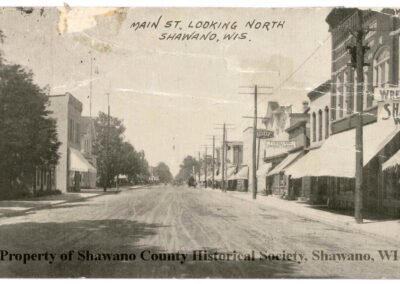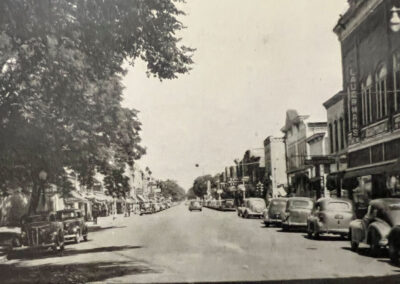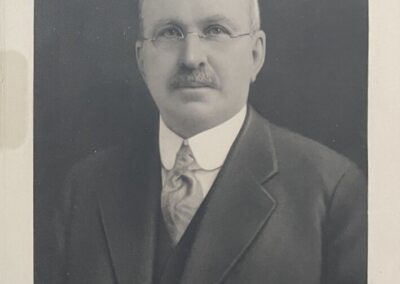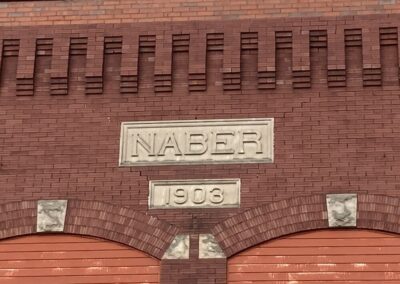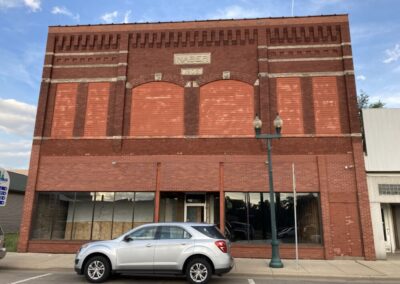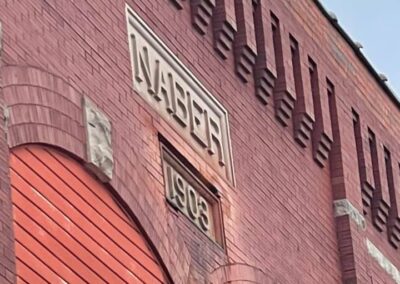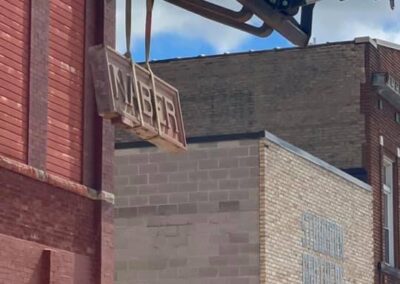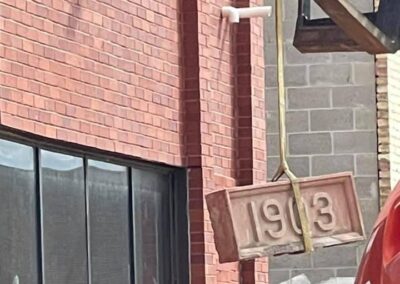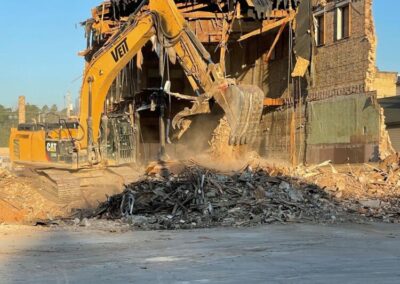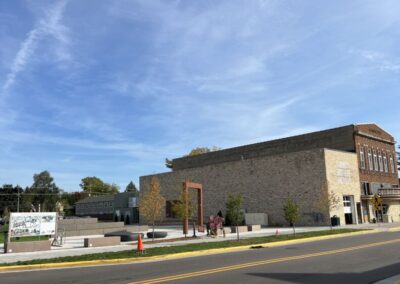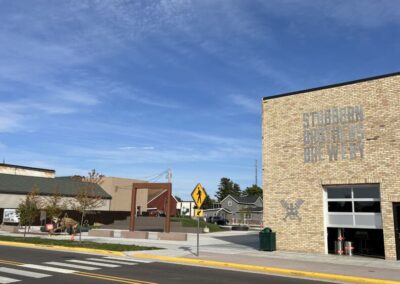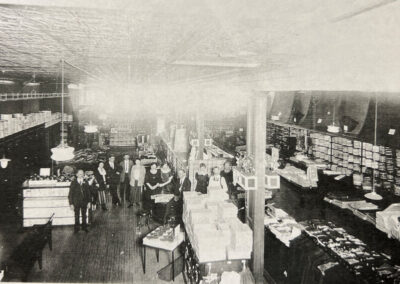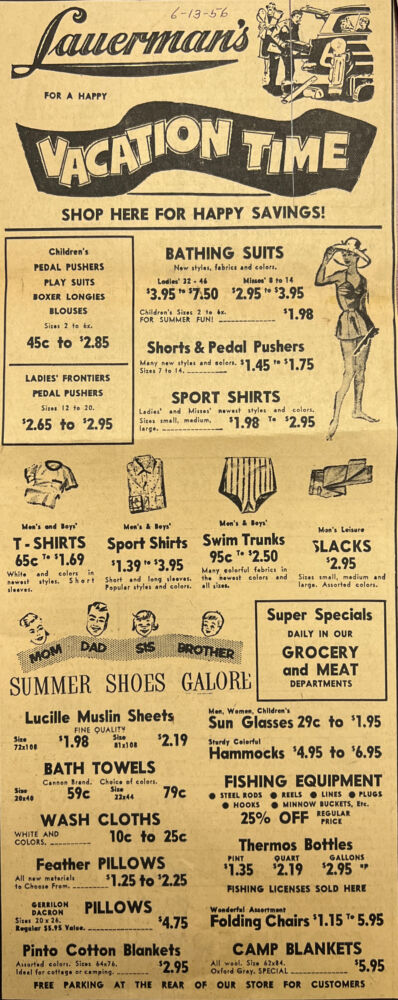Location
Photo Gallery
A Brief History
The Naber Building
214 S. Main St.
Shawano, Wisconsin
Built in 1903, this building was the home of several businesses for many years before being demolished in 2022, to make way for a public space linking the Shawano’s Main Street Historic District to Franklin Park. The new name is, The Naberhood Plaza.
**************
With the dedication of The Naberhood on April 21, 2023, it’s important to outline information about Franklin D. Naber, the namesake of the plaza. The Naber building was demolished to make way for the new plaza linking Main Street to Franklin Park. F. D. Naber was a “giant” in the City of Shawano, accomplishing a great deal for the city and in business.
Franklin Diedrich Naber
21 May 1853 – 29 July 1925
F. D. NABER – Prominent among the foremost, in progressiveness and prosperity, of Shawano county business men, stands this gentleman, a worthy son, of a worthy father—Judge Naber.
Birth: 21 MAY 1853 Mayville, Dodge,WI
Death: 29 Jul 1925 Shawano, Wisconsin
Burial: Sacred Heart Cemetery, Shawano, Wisconsin
Franklin Diedrich Naber was born May 21, 1853, in Maysville, Dodge County to parents Herman and Margaret Naber where, when a child, his parents left him in the care of his grandfather Naber. When they moved to Shawano they found the schools inferior to those of Mayville. So he remained until he was fourteen years old, receiving his elementary educational training in Maysville where the schools he attended being for the most part German; then, rejoining his parents at Shawano, he completed his education at the English school of that then village, which was held in a frame building still to be seen in the southwest portion of the present city limits. His school days over at an early age, he entered his father’s store, where his first lessons in mercantile business were secured, and while yet a boy he began to buy and sell land for the timber growing on it, showing an unusually early aptitude for commercial life. All his transactions in those days, up to the time of his majority, were made, necessarily, in his father’s name, and the success of his ventures were the foreshadowing of his future prosperity.
He thus, continued till he had passed his majority and reached the prime of his early manhood, when he began to launch into still wider fields. In 1881 he purchased from Charles L. Wiley the then almost defunct drug store in Shawano, the fixtures being worth $1,300, while the value of the stock amounted to not more than $400; but the push, energy and sound management of Mr. Naber soon fanned the embers of an expiring business into new and healthy life, for ere long the drug store became one of the most popular and extensive in northern Wisconsin—in fact, no town in all the State, of the size of Shawano, could boast of such a well-equipped store, at the same time enjoying so large a patronage. In 1884 a new business block one of the best in Shawano, was built to accommodate the increasing trade, but in 1893 our F. D. Naber, on account of failing health, had to retire from the business, his brother, Charles C. (who had been employed in the store some ten years), succeeding him. Charles continued to conduct the concern till June, 1894, when the hand of Death removed him from his usefulness. The drug business was then formed into a stock company, entitled the Naber Drug Co., with F. D. Naber as vice-president.
In February, 1894, our Mr. Naber was active in the formation of the Wolf River Paper and Fibre Co., who erected an extensive plant at Shawano for the manufacture of paper pulp from wood, which plant was equipped with the latest improved machinery, etc. Of this important industry Mr. Naber was elected treasurer and appointed superintendent, incumbencies he has since filled with eminent ability. He is also president of the Shawano Water-power Co., who constructed a dam at Shawano; is vice-president of the Shawano Shoe Co., and a director of the Shawano Bank. To the City of Shawano he has made two additions, known, respectively, as “Naber’s Addition” and “Fairview Addition,” one of which has been made to the southeast part of the corporation limits; and in very many other ways has he enhanced the growth and prosperity of the city of his adoption. In 1891 he completed what is said to be the finest private residence in the city, where he and his family live, and he also owns several other dwelling houses.
On August 8, 1882, Mr. Naber was married married to Mary Bucholtz in Clintonville, WI, a native of Belle Plaine township, Shawano County. Mary was the daughter of Alexander Bucholtz who was among the noble army of pioneers of Shawano County. Four bright children have been born to this union, their names and dates of birth being as follows: F. Bernard, September 17, 1883; Paulina M., June 15, 1885; Alexander H., October 10, 1888, and Charles F., January 21, 1895.
Although Mr. Naber has ever been foremost in all movements tending to the welfare and prosperity of the community at large, yet he has never aspired to political honor, being content, as a stanch Democrat, to give his friends and party the benefit of his influence, aside from which, politics have no attractions for him. In addition to his other interests Mr. Naber owns several thousand acres of timber land, and for years he has been engaged in buying and selling that class of real estate. In every way he is one of the leading men of Shawano County, one of the shrewdest, most capable and yet most unassuming, a happy combination of characteristics that have won for him many warm friends.
Franklin Naber was a prominent Shawano citizen. He had many accomplishments in his lifetime, including platting 3 subdivisions within our community, starting the paper mill, and developing several significantly historic downtown buildings. Some of these developments include the building that Driers Pharmacy currently occupies as well as the building that previously housed Lauerman’s and Senzig’s furniture and stood on the current site of the plaza space.
From the 1999 National Register of Historic Places Registration application:
This commercial block is one of the largest buildings in the district, and despite alterations is still a visually significant edifice. The two-story load-bearing brick building is capped by a plain corbeled brick cornice, under which, at the center of the facade, is a stone bearing the name of the initial owner and a smaller stone beneath bearing the date of construction. The building’s upper facade is divided into three bays by two brick piers; the center portion is slightly less than one and one-half times the width of the other two combined. The areas between the cornice and the second-story windows are delineated on the two side bays by three stone stringcourses that traverse the bays and the piers on either side. These are evenly spaced, with the lowest stringcourse being slightly wider than the other two. The center bay does not have these stringcourses, that area on this bay being occupied by the name and date stones described previously.
Each of the side bays has a pair of tall, narrow windows whose lintels are formed by the lowest stringcourse, described previously, and whose sills are formed by an additional, narrower stringcourse that traverses the entire facade immediately below the windows. The central bay has a pair of segmented arched windows, each approximately twice the width of one of the side windows; the segmented arches have stone keystones and springers. The windows’ sills are also part of the lower stringcourse across the facade, as described previously. The glazing of all of the windows at this time is covered with siding material. The two piers dividing the upper facades bays terminate in corbels below the stringcourse and immediately before the storefront transom area. The storefront transom area, the storefront piers at either side, and a former doorway leading to theupper floor are all obscured by an applied false brick covering. Like many of Shawano’s historic retail buildings, the storefront itself was renovated to reflect contemporary marketing theory during the historic period; the present storefront has a high level of integrity as a result.
The storefront’s facade display windows give way at the center of the building to the original square cast-iron piers, which have fluted bases and slightly recessed panels in the centers of their lengths. Adjoining these piers are display windows that recess into the building at an angle perpendicular to the street and terminate approximately three feet short of the plane of the door in a narrow display window parallel to the storefront windows. These in turn each terminate at another narrow display window, which proceeds inward to the frame of the door, but at a slightly obtuse angle from the adjoining window, rather than at a perpendicular angle. The door and its transom themselves are aluminum and non-historic. All of the display windows are framed in narrow strips of molded copper. This storefront is one of the more sophisticated of the historic storefronts in the district and excellently represents the common redesign of such features during the early twentieth century.

